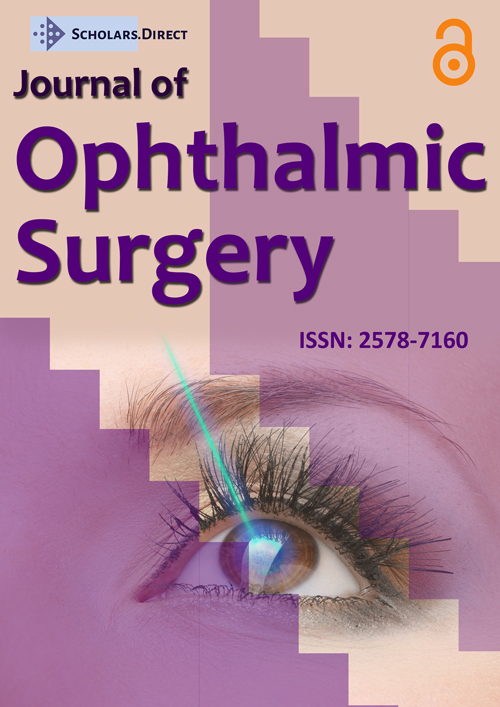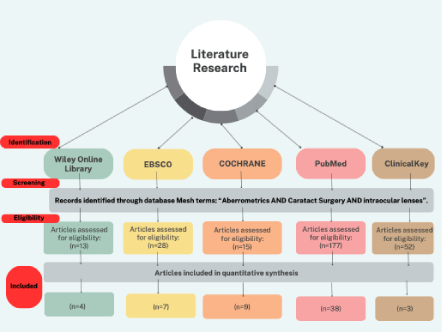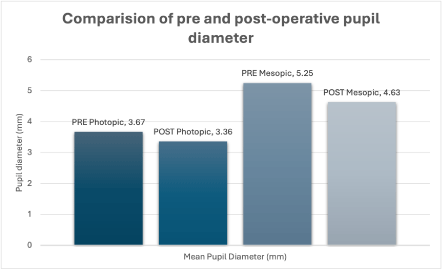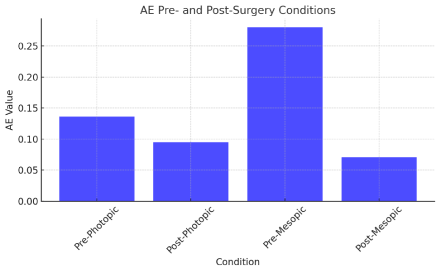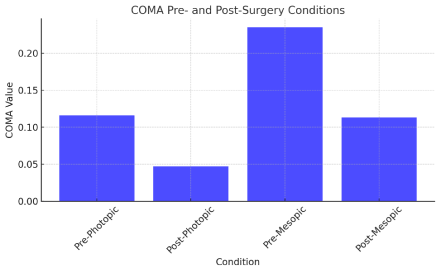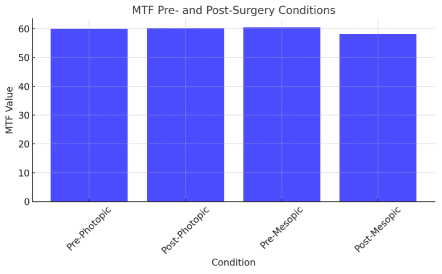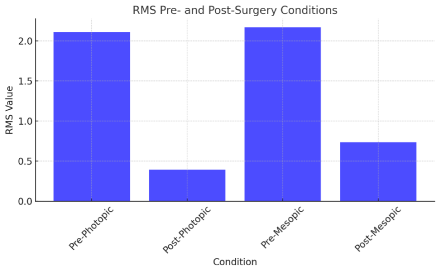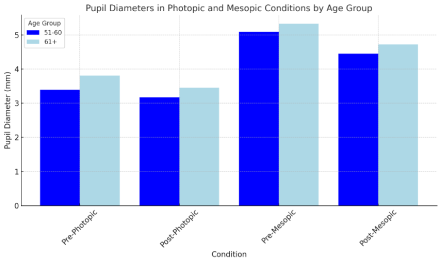Aberrometric Impact in Post-Cataract Surgery Patients with High-Tech Intraocular Lenses
Abstract
Introduction: Premium intraocular lenses have captured the vision of the most demanding users around the world; however, aberrometric phenomena are the most responsible for patient discomfort when we talk about the quality of life.
Objective: The objective is to evaluate pre surgical high order aberrations and their impact on post-surgical outcome, after cataract surgery with high-tech lenses.
Methods: We present an original, single-center, retrospective, and descriptive study, performed at “Puerta de Hierro” Hospital in Guadalajara, Jalisco, Mexico. Between January 2024 to December 2024, we obtained a total of 43 patients, of which 64 eyes corresponded, whether they had cataract surgery on one or both eyes and with an intraocular premium lens, performed by the same surgeon.
Results: 64 eyes of 43 patients were evaluated for this study. The demographic distribution was 21 men and 22 women with a mean age of 62.98 ± 4.808 years. The mean pupil diameter in pre-operative surgery conditions in photopic conditions was 3.67 ± 0.64 mm and pre-operative surgery in mesopic conditions was 5.25 ± 0.76 mm. The mean pupil diameter in the post-operative photopic conditions was 3.36 ± 0.54 mm and the post-operative mesopic conditions were 4.63 ± 0.69 mm.
Conclusion: In conclusion the lack of consensus or real or specific information regarding corneal aberrations in premium lenses motivates this type of study to be possible. The quality of vision compared to previous years was evaluated subjectively, today it can be objectified and promote true visual quality.
Keywords
Cataract, Aberrometric, Intraocular lens, Surgery, Quality of life
Introduction
Premium intraocular lenses have captured the vision of the most demanding users around the world; however, aberrometric phenomena are the most responsible for patient discomfort when we talk about the quality of life.
There are multiple artifacts or sensations of halos or glare, characterized by occurring in certain lighting conditions and a certain position of incidence, leading to this phenomenon. The values that are disregarded or overlooked in the calculations of different equipment’s, today we know, have a substantial impact on the final visual quality. Such measurements and information related to assessing the pre-surgical values of high-order aberrations (HOA), coma, trefoil, sphere, corneal surface regularity index (SRI), root mean square (RMS), chord m, pupillary dimensions under different conditions, as: mesopic, photopic and scotopic [1-11].
Espaillat and colleagues [11], the better visual acuity at the time of surgery, the more likely they perceive halos and dysphotopic phenomena than those compared with worse visual acuity within 1 month and 6 months after cataract surgery. In addition to this, it is studied that with great influence, the HOA spherical type was the most prevalent at the time of pseudophakia concerning glare and halos. The documented ranges in microns with a lower incidence of HOA are proposed in values or parameters close to 0.200-0.399 mm, which after 1 month of cataract surgery, have fewer photopic events. Nevertheless, coma HOA, after 6 months was more associated with halos phenomena, that is, the lower the coma, the lower the probability at 6 months of perceiving halos with a proposed value of 0.000-0.199 mm.
In the other hand, an element that is not very associated and that impacts the visual quality, is chord m and its high value or presence (0.30 ± 0.15 mm) with 1 and 6 months of follow-up and the appearance of glare, being in world literature a cut-off value of > 0.6 mm, however, not always in a practically measurable way [1-11].
Corneal aberrations are defined as a wavefront false image, which derives from Snell's law and by changing from one medium like water to air or another one and therefore do not constitute a real or true image [2-6].
Low-order corneal aberrations (LOA) are responsible for 85 % of the total aberrations; this means that the remaining 15 % are HOA which cannot be corrected by refractive surgery or spherocylindrical lenses. On the other hand, the most frequent HOA's are coma and spherical ones. It is well known that the larger the pupil diameter, the larger the HOA's are going to be. Furthermore, all HOA's defects are dependent on pupil diameters in different light conditions. The interpretation of the models of the wave light of the light, through mathematics, allows the creation of polynomials, such as the case of the Zernike Polynomial, which provides a quantitative description of this aberration [12-18].
The modulation transfer function (MTF) is what the technological devices would represent, the contrast and sensitivity, allowing a high quality of image definition, in the eye depending on the cornea and providing the different details of an image. The point spread function (PSF), at the level of the occipital cortex, allows evaluation of the intensity of the wave coming from space through the optical system, from the cornea to the retina, thus measuring the final visual quality. Through RMS we can numerically measure the deviations of the light wave when compared with a perfect dioptric system [19-24].
The objective is to evaluate pre surgical high order aberrations and their impact on post-surgical outcome, after cataract surgery with high-tech lenses.
Methods
We present an original, single-center, retrospective, and descriptive study, performed at “Puerta de Hierro” Hospital in Guadalajara, Jalisco, Mexico. Between January 2024 to December 2024, we obtained a total of 43 patients, of which 64 eyes corresponded, whether they had cataract surgery on one or both eyes and with an intraocular premium lens, performed by the same surgeon.
The corneal aberrations were measured by the OPD-Scan III which measures corneal topography, wavefront aberrations, autorefraction, keratometry, pupillometry, and same-axis pupillography.
Inclusion criteria
The patients with a previous diagnosis of cataract according to the LOCSIII classification criteria, aged 50 years and older.
Exclusion criteria
The patients with any corneal pathology, underlying diseases such as: glaucoma, pseudoexfoliation, dry eye and retinal pathologies, as well as post-operative refractive surgery such as: Laser-assisted in situ keratomileusis (LASIK), Photorefractive keratectomy (PRK), Small incision lenticule extraction (SMILE) or Radiated Keratectomy (Figure 1).
This study complies with the Declaration of Helsinki as well as informed consent form from each of the participants. Additionally approved by the ethics committee of the same hospital.
Results
Statistical analysis
64 eyes of 43 patients were evaluated for this study. The demographic distribution was 21 men and 22 women with a mean age of 62.98 ± 4.808 years.
The mean pupil diameter in pre-operative surgery conditions in photopic conditions was 3.67 ± 0.64 mm and pre-operative surgery in mesopic conditions was 5.25 ± 0.76 mm. The mean pupil diameter in the post-operative photopic conditions was 3.36 ± 0.54 mm and the post-operative mesopic conditions were 4.63 ± 0.69 mm. Table 1 and Figure 2.
In the other hand, the values were distributed not only by being before or after surgery, but also by age groups, as shown in Table 2 and Figure 3.
The statistical analysis was also carried out by individual corneal aberration for greater precision (Figure 3, Figure 4, Figure 5 and Figure 6).
Finally, we compared pupil diameters in mesopic and photopic conditions in different age groups (Figure 7).
Parameters were evaluated using the Shapiro-Wilk test for normal distribution. For values with a normal distribution, the T test for related samples was used and for those that did not have a normal distribution, the Wilcoxon test was used (Table 3).
Discussion
Many of the corneal aberration studies consider results as global corneal aberrations; the value of breaking down each one of them allows a finer and more precise analysis. It is important to point out that: off-center shots of the corneal apex, in any of its quadrants, induce corneal aberrations that are not necessarily found in the patient.
Since the aberrations are pupil-dependent, we observe that the pre-surgical values in photopic conditions behave differently in the age groups, especially those over 61 years of age. Furthermore, and on the contrary, there is a more stable relationship in post-surgical photopic conditions in relation to the binocular vision evaluation. Interesting description, because as we said previously, the conditions before and after surgery, but by age groups, are not usually united in the same study [24-30].
The behavior of coma, in accordance with the universal literature, behaved in an expected manner in photopic and mesopic pre-surgical conditions, where the less pre-surgical coma, the less post-surgical coma, thus benefiting the patient in being the greatest annoying elements in HOA's.
The values found for MTF, furthermore, present a practically linear relationship in the pre-surgical photopic and mesopic condition, and barely decreased in the post-surgical value in mesopic, not so for photopic, allowing to directly associate a stable behavior even after being operated, a notable element for a multifocal and extended-depth-of-focus (EDOF) lenses [31-36].
The EDOF lenses today have become inherent to a new non-diffractive technology, but they are nevertheless dependent on pupil size for near vision, hence the importance of measuring it, ectopic pupil evaluations and knowing which patients really could benefit from this type of technology [23].
The light deviation that we present, evaluated by RMS, in photopic and mesopic pre-surgical conditions was distributed equally, however not for post-surgical conditions, better especially in mesopic conditions [37-40].
The comparison of pupils in diameter, by age group and in the different light conditions, showed to be greater in the group over 61 years of age, data of special attention for us refractive surgeons.
One of the most important phenomena when measuring corneal aberrations is decentration and tilt. On the other hand, the same measurement instruments present discrepancies between the equipment when documenting the aberrations. Currently, there is a lack of reliable scientific data evidence about visual quality concerning tilt and decentration, after cataract surgery, the decentration can be 0.2 - 0.3 mm with a tilt of 2-3 ° degrees, 10% of patients who move more than 0.5 mm or 5 ° degrees. In vitro, studies of aspheric IOLs present greater decentration and tilt than those compared to spherical ones. In addition, it is completely correlated that the initial decentration or in pre-surgical studies is proportional to the result, and if from the beginning there is no centered IOL, the effective lens position (ELP) will not be accomplished [39].
The experimental models, evaluating a cataract surgery or a phacorefractive surgery also impact differently on the aberration wavefront, since in young patients, the positive spherical aberrations coming from the cornea are counteracted due to the aberrometric negative spherical power of the transparent natural lens, phenomenon that, on the contrary, occurs in cataracts in senile patients, leading to a final distortion of visual quality [41-43].
On the other hand, the dispersion of the material must be considered, since the manufacture of IOLs is usually under conditions of monochromatic green spectrum, it is necessary to introduce that the measure of the Abbe number, allows the direct correlation that could be quantified, and result that the lower the Abbe number, the greater will be the dispersion color, translating this into a chromatic wavelength aberration. However, this longitudinal chromatic aberration induced by the lens itself allows us to describe the inability of the visual system to refract the propagation of light and the color spectrum to the same focal point [44-47].
The Femtosecond laser assisted cataract surgery (FLACS), being able to guarantee the effective position of the intraocular lens during surgery is more precise today thanks to the application of these new technologies. It has been studied over the years, the substantial difference that exists in the immediate and long-term postoperative period, when performed conventionally phacoemulsification surgery. In the other hand, the HOA and spherical aberrations are lower in FLACS, in addition to contributing substantially to the lower amount of decentration and thus the tilt [48].
The replicability capacity of FLACS made it objective, repetitive and forceful manner; the aberrations studied are in measurements of size, shape and position, comparable and therefore predictable. Thus, making a smaller sum of total aberrations at the end [49-56].
The different variables can be analyzed, one at a time, however, considering the RMS as a total of the aberration value and thus the final clinical behavior, allows us to globally anticipate its result [48].
On the other hand, it seems that comparing trefoil vs spherical at 6 months, the trefoil aberration is higher at the end of this time. In addition, we find one more variable, which is little studied or documented when talking about HOA's, it is the type of intraocular lens and its aspherical and spherical shape, the first being the one with the lowest aberration index [48,57,58].
Documenting the difference that exists between multifocal and monofocal intraocular lenses, in addition with the pupil diameter, interestingly allows us to distinguish that in FLACS there are higher MTF values than in conventional cataract surgery when starting from a pupil diameter of 4.5 mm. Thus, concluding that these patients are the ones who will clinically show better visual acuity [54,55].
As J Miret [33] and colleagues said, positive spherical aberrations are produced by spherical surfaces, while with aspheric surfaces, they can be only controlled. There are elements that were previously explored as possible and today constitute a reality; such is the case of the design of trifocal lenses, whose diffractive base is curved butconstitutes at the end a spherical surface [33].
Another important element is that in all studies, the refractive target is suggested to be 0.5 D, however this is done by spherical equivalent, being this an area of opportunity because many sums could give that final refractive value, without this meaning truly good final visual acuity for the patients [1].
The advancement of technology with respect to artificial intelligence has reached ophthalmology, the need to predict and alert errors has allowed it to be used to prevent refractive surprises. It was documented that when choosing the Barret true K and Hill formula RBF (radial basis function) they are equiparable between each other as they are targeting a refractive target of 0.5 D [5].
In addition, like Alba-Bueno and cols [1], when comparing 5 diffractive IOL's, demonstrated that the greater the addition of power to the lens, the greater the sensation and size of the halos reported by the patient. This is of great value since we can uniquely specify the need for an accurate calculation.
For a long time throughout the development of intraocular lenses, the possibility raised that internal aberrations were typical of the IOL; however, today it has been shown that they do not actively participate in this light dispersion and therefore the HOA's, spherical and comma, were not the most disabling [20].
Personalized medicine is becoming more and more real in ophthalmology, where the visual needs of each patient are different, knowing and having the best information available at the time of surgery, allows having a direct and substantial impact, with the selected lens, according to each type of patient [48,56-58].
Conclusion
In conclusion the lack of consensus or neither real nor specific information regarding corneal aberrations in premium lenses, motivates this type of study to be possible. The quality of vision compared to previous years was evaluated subjectively, today it can be objectified and promote true visual quality. Knowing the specific characteristics of the IOL as well as its properties today constitutes a different starting point to understand their correction and explain the great world of corneal aberrations.
Disclosure
The authors report no conflicts of interest in this work.
Conflict of Interest
None.
References
- Alba-Bueno F, Garzón N, Vega F, et al. (2017) Patient-perceived and laboratory-measured halos associated with diffractive bifocal and trifocal intraocular lenses. Curr Eye Res 43: 35-42.
- Alio JL, D’Oria F, Toto F, et al. (2021) Retinal image quality with multifocal, EDoF, and accommodative intraocular lenses as studied by pyramidal aberrometry. Eye Vis 8: 37.
- Alió JL, Kaymak H, Breyer D, et al. (2017) Quality of life related variables measured for three multifocal diffractive intraocular lenses: A prospective randomised clinical trial. Clin Exp Ophthalmol 46: 380-388.
- Ashena Z, Gallagher S, Naveed H, et al. (2022) Comparison of anterior corneal aberrometry, keratometry and pupil size with scheimpflug tomography and ray tracing aberrometer. Vision 6: 18.
- Bhasin P, Sarkar D, Bhasin P, et al. (2024) Visual performance and patient satisfaction with AcrySof® IQ Vivity® IOL: Experience from a tertiary care center in central India. Indian J Ophthalmol 72: 554-557.
- Castillo RA, Hernández QE (2008) Aberraciones corneales de alto orden. ¿Un método para graduar al queratocono?. Rev Mex Oftalmol 82: 369-375.
- Cerviño A, Esteve-Taboada JJ, Chiu Y-F, et al. (2024) Tolerance to decentration of biaspheric intraocular lenses with refractive phase-ring extended depth of focus and diffractive trifocal designs. Graefes Arch Clin Exp Ophthalmol 262: 2541-2550.
- Chen AJ, Long CP, Lu T, et al. (2023) Accuracy of intraoperative aberrometry versus modern preoperative methods in post-myopic laser vision correction eyes undergoing cataract surgery with capsular tension ring placement. Graefes Arch Clin Exp Ophthalmol 262: 1545-1552.
- Chuck RS, Jacobs DS, Lee JK, et al. (2018) et al. Refractive errors & refractive surgery preferred practice pattern®. Ophthalmology 125: P1-P104.
- Danzinger V, Schartmüller D, Schwarzenbacher L, et al. Clinical prospective intra-individual comparison after mix-and-match implantation of a monofocal EDOF and a diffractive trifocal IOL. Eye 38: 321-327.
- Espaillat A, Coelho C, Medrano Batista MJ, et al. (2021) Predictors of photic phenomena with a trifocal IOL. Clin Ophthalmol 15: 495-503.
- Fernández J, Rodríguez-Vallejo M, Martínez J, et al. (2019) Prediction of visual acuity and contrast sensitivity from optical simulations with multifocal intraocular lenses. J Refract Surg 35: 789-795.
- Fu Y, Kou J, Chen D, et al. (2019) Influence of angle kappa and angle alpha on visual quality after implantation of multifocal intraocular lenses. J Cataract Refract Surg 45: 1258-1264.
- Furlan WD, Martínez-Espert A, Montagud-Martínez D, et al. (2023) Optical performance of a new design of a trifocal intraocular lens based on the Devil’s diffractive lens. Biomed Opt Express 14: 2365.
- García S, Salvá L, García-Delpech S, et al. (2023) Numerical analysis of the effect of decentered refractive segmented extended depth of focus (EDoF) intraocular lenses on predicted visual outcomes. Photonics 10: 850.
- Garzón N, García-Montero M, López-Artero E, et al. (2019) Influence of trifocal intraocular lenses on standard autorefraction and aberrometer-based autorefraction. J Cataract Refract Surg 45: 1265-1274.
- Gatinel D, Rampat R, Dumas L, et al. (2020) An alternative wavefront reconstruction method for human eyes. J Refract Surg 36: 74-81.
- Gatinel D, Rampat R, Malet J, et al. (2020) Wavefront sensing, novel lower degree/higher degree polynomial decomposition and its recent clinical applications: A review. Indian J Ophthalmol 68: 2670.
- Huh J, Eom Y, Yang SK, et al. (2021) A comparison of clinical outcomes and optical performance between monofocal and new monofocal with enhanced intermediate function intraocular lenses: A case-control study. BMC Ophthalmol 21: 365.
- Imburgia A, Gaudenzi F, Mularoni K, et al. (2022) Comparison of clinical performance and subjective outcomes between two diffractive trifocal intraocular lenses (IOLs) and one monofocal IOL in bilateral cataract surgery. Front Biosci (Landmark Ed) 27: 41.
- Ishiguro N, Horiguchi H, Katagiri S, et al. (2022) Correlation between higher-order aberration and photophobia after cataract surgery. PLoS One 17: e0274705.
- Jameel A, Dong L, Lam CFJ, et al. (2023) Attitudes and understanding of premium intraocular lenses in cataract surgery: A public health sector patient survey. Eye 38: 76-81.
- Jeon S, Choi A, Kwon H (2022) Analysis of uncorrected near visual acuity after extended depth-of-focus AcrySof® Vivity™ intraocular lens implantation. PLoS One 17: e0277687.
- Kawamura J, Tanabe H, Shojo T, et al. (2024) Comparison of visual performance between diffractive bifocal and diffractive trifocal intraocular lenses. Sci Rep 14: 5292.
- Kim JW, Eom Y, Bae SH, et al. (2024) Visual outcomes according to age after bilateral implantation of trifocal intraocular lenses. J Refract Surg 40: e270-e277.
- Labuz G, Güngör H, Auffarth GU, et al. (2023) Altering chromatic aberration: how this latest trend in intraocular-lens design affects visual quality in pseudophakic patients. Eye Vis 10: 49.
- Labuz G, Yan W, Baur ID, et al. (2023) Comparison of five presbyopia-correcting intraocular lenses: Optical-bench assessment with visual-quality simulation. J Clin Med 12: 2523.
- Li L-P, Mao D-S, Hua X, et al. (2024) Systematic bibliometric analysis of research hotspots and trends on the application of premium IOLs in the past 2 decades. Int J Ophthalmol 17: 736-747.
- Liu X, Wu X, Huang Y (2022) Laboratory evaluation of halos and through-focus performance of three different multifocal intraocular lenses. J Refract Surg 38: 552-558.
- Fan Y-Y, Sun C-C, Chen H-C, et al. (2018) Photorefractive keratectomy for correcting residual refractive error following cataract surgery with premium intraocular lens implantation. Taiwan J Ophthalmol 8: 149-158.
- Ma J, El-Defrawy S, Lloyd J, et al. (2023) Prediction accuracy of intraoperative aberrometry compared with preoperative biometry formulae for intraocular lens power selection. Can J Ophthalmol 58: 2-10.
- Markuszewski B, Wylegala A, Szentmáry N, et al. (2023) Comparative analysis of the visual, refractive and aberrometric outcome with the use of 2 intraocular refractive segment multifocal lenses. J Clin Med 13: 239.
- Miret JJ, Camps VJ, García C, et al. (2022) Analysis and comparison of monofocal, extended depth of focus and trifocal intraocular lens profiles. Sci Rep 12: 8654.
- Ni S, Zhuo B, Cai L, et al. (2024) Visual outcomes and patient satisfaction after implantations of three types of presbyopia-correcting intraocular lenses that have undergone corneal refractive surgery. Sci Rep 14: 8386.
- Niazi S, Gatzioufas Z, Dhubhghaill SN, et al. (2024) Correction to: Association of patient satisfaction with cataract grading in five types of multifocal IOLs. Adv Ther 41: 1774.
- Ning J, Zhang Q, Liang W, et al. (2024) Bibliometric and visualized analysis of posterior chamber phakic intraocular lens research between 2003 and 2023. Front Med 11: 1391327.
- Palomino-Bautista C, Sánchez-Jean R, Carmona-Gonzalez D, et al. (2021) Depth of field measures in pseudophakic eyes implanted with different type of presbyopia-correcting IOLS. Sci Rep 11: 12081.
- Palomino-Bautista C, Sánchez-Jean R, Carmona-González D, et al. (2019) Subjective and objective depth of field measures in pseudophakic eyes: Comparison between extended depth of focus, trifocal and bifocal intraocular lenses. Int Ophthalmol 40: 351-359.
- Pan R-L, Tan Q-Q, Liao X, et al. (2024) Effect of decentration and tilt on the in vitro optical quality of monofocal and trifocal intraocular lenses. Graefes Arch Clin Exp Ophthalmol 262: 3229-3242.
- Pedrotti E, Carones F, Talli P, et al. (2020) Comparative analysis of objective and subjective outcomes of two different intraocular lenses: Trifocal and extended range of vision. BMJ Open Ophthalmol 5: e000497.
- Pérez-Merino P, Aramberri J, Quintero AV, et al. (2023) Ray tracing optimization: A new method for intraocular lens power calculation in regular and irregular corneas. Sci Rep 13: 4555.
- Qu H, Abulimiti A, Liang J, et al. (2024) Comparison of short-term clinical outcomes of a diffractive trifocal intraocular lens with phacoemulsification and femtosecond laser assisted cataract surgery. BMC Ophthalmol 24: 189.
- Rementería-Capelo LA, Contreras I, Morán A, et al. (2023) Visual performance of eyes with residual refractive errors after implantation of an extended vision intraocular lens. J Ophthalmol 2023: 7701390.
- Salgado RMPC, Torres PFAAS, Marinho AAP (2024) Pupil versus 1st Purkinje capsulotomy centration with femtosecond laser: Long term outcomes with a sinusoidal trifocal lens. J Biophotonics 17: e202300446.
- Seiler TG, Wegner A, Senfft T, et al. (2019) Dissatisfaction after trifocal IOL implantation and its improvement by selective wavefront-guided LASIK. J Refract Surg 35: 346-352.
- Sezenöz AS, Güngör SG, Dogan IK, et al. (2024) The effect of trifocal and extended-depth-of-focus intraocular lenses on optical coherence tomography parameters. Indian J Ophthalmol 72: S423-S428.
- Son HS, Labuz G, Khoramnia R, et al. (2020) Ray propagation imaging and optical quality evaluation of different intraocular lens models. PLoS One 15: e0228342.
- Zhong Y, Zhu Y, Wang W, et al. (2021) Femtosecond laser-assisted cataract surgery versus conventional phacoemulsification: Comparison of internal aberrations and visual quality. Graefes Arch Clin Exp Ophthalmol 260: 901-911.
- Vidal Olarte R (2011) Entendiendo e interpretando las aberraciones ópticas. Cienc Tecnol Salud Vis Ocul 9: 105-122.
- Villegas EA, Manzanera S, Lago CM, et L, (2019) Effect of crystalline lens aberrations on adaptive optics simulation of intraocular lenses. J Refract Surg 35: 126-131.
- Wang JM, Che JB, Yuan XW, et al. (2024) [Effects of different types of intraocular lens implantation on patient's visual quality and function after phacoemulsification]. Zhonghua Yi Xue Za Zhi 104: 1391-1396.
- Xiong J, Xu J, Zhou M, et al. (2024) Mesopic pupil indices as potential risk factors for glare disability after intraocular implantable collamer lens implantation: Prospective study. J Cataract Refract Surg 50: 565-571.
- Xu J, Zheng T, Lu Y (2019) Effect of decentration on the optical quality of monofocal, extended depth of focus, and bifocal intraocular lenses. J Refract Surg 35: 484-492.
- Yan W, Labuz G, Khoramnia R, et al. (2023) Trifocal intraocular lens selection: Predicting visual function from optical quality measurements. J Refract Surg 39: 111-118.
- Zamora-de La Cruz D, Bartlett J, Gutierrez M, et al. (2023) Trifocal intraocular lenses versus bifocal intraocular lenses after cataract extraction among participants with presbyopia. Cochrane Database Syst Rev.
- Zhong Y, Wang K, Yu X, et al. (2021) Comparison of trifocal or hybrid multifocal-extended depth of focus intraocular lenses: A systematic review and meta-analysis. Sci Rep 11: 6699.
- Zhou S, Figueiredo AG de A, Abulimiti A, et al. (2023) Evaluation of life quality of patients submitted to cataract surgery with implantation of trifocal intraocular lenses. J Pers Med 13: 451.
- Zvornicanin J, Zvornicanin E (2018) Premium intraocular lenses: The past, present and future. J Curr Ophthalmol 30: 287-296.
Corresponding Author
Arturo Iván Pérez Pacheco, Ophthalmological Department of Cataract and Refractive Surgery, Puerta de Hierro Hospital, Empresarios Avenue # 150, Puerta de Hierro Hospital, Zip code # 45116 Zapopan, Jalisco, Mexico, Tel: +52-33-3809-3827.
Copyright
© 2025 Hernandez MAI. This This is an open-access article distributed under the terms of the Creative Commons Attribution License, which permits unrestricted use, distribution, and reproduction in any medium, provided the original author and source are credited.

